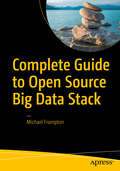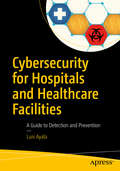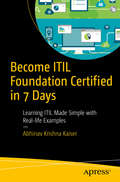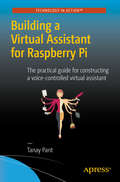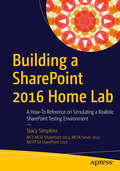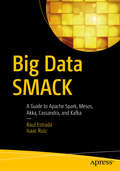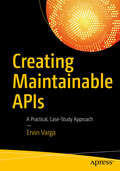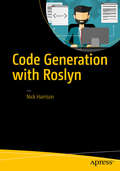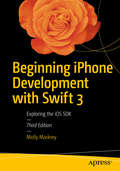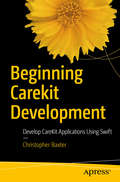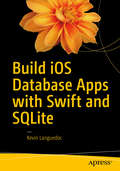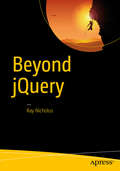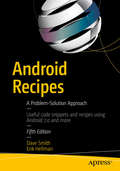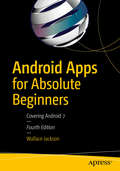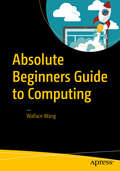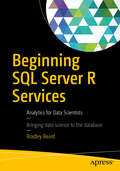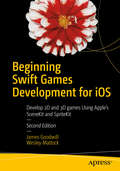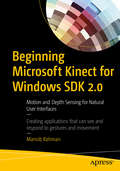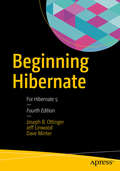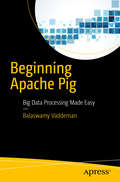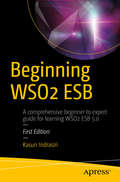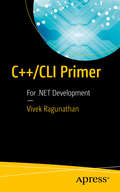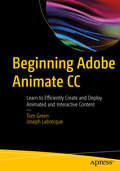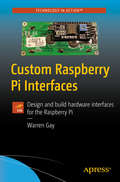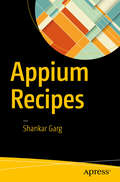- Table View
- List View
Complete Guide to Open Source Big Data Stack
by Michael FramptonSee a Mesos-based big data stack created and the components used. You will use currently available Apache full and incubating systems. The components are introduced by example and you learn how they work together. In the Complete Guide to Open Source Big Data Stack, the author begins by creating a private cloud and then installs and examines Apache Brooklyn. After that, he uses each chapter to introduce one piece of the big data stack--sharing how to source the software and how to install it. You learn by simple example, step by step and chapter by chapter, as a real big data stack is created. The book concentrates on Apache-based systems and shares detailed examples of cloud storage, release management, resource management, processing, queuing, frameworks, data visualization, and more. What You'll Learn Install a private cloud onto the local cluster using Apache cloud stack Source, install, and configure Apache: Brooklyn, Mesos, Kafka, and Zeppelin See how Brooklyn can be used to install Mule ESB on a cluster and Cassandra in the cloud Install and use DCOS for big data processing Use Apache Spark for big data stack data processing Who This Book Is For Developers, architects, IT project managers, database administrators, and others charged with developing or supporting a big data system. It is also for anyone interested in Hadoop or big data, and those experiencing problems with data size.
Cybersecurity for Hospitals and Healthcare Facilities: A Guide to Detection and Prevention
by Luis AyalaLearn how to detect and prevent the hacking of medical equipment at hospitals and healthcare facilities. A cyber-physical attack on building equipment pales in comparison to the damage a determined hacker can do if he/she gains access to a medical-grade network as a medical-grade network controls the diagnostic, treatment, and life support equipment on which lives depend. News reports inform us how hackers strike hospitals with ransomware that prevents staff from accessing patient records or scheduling appointments. Unfortunately, medical equipment also can be hacked and shut down remotely as a form of extortion. Criminal hackers will not ask for a $500 payment to unlock an MRI, PET or CT scan, or X-ray machine--they will ask for much more. Litigation is bound to follow and the resulting punitive awards will drive up hospital insurance costs and healthcare costs in general. This will undoubtedly result in increased regulations for hospitals and higher costs for compliance. Unless hospitals and other healthcare facilities take the steps necessary to secure their medical-grade networks, they will be targeted for cyber-physical attack, possibly with life-threatening consequences. Cybersecurity for Hospitals and Healthcare Facilities is a wake-up call explaining what hackers can do, why hackers would target a hospital, the way hackers research a target, ways hackers can gain access to a medical-grade network (cyber-attack vectors), and ways hackers hope to monetize their cyber-attack. By understanding and detecting the threats, you can take action now--before your hospital becomes the next victim. What You Will Learn: Determine how vulnerable hospital and healthcare building equipment is to cyber-physical attack Identify possible ways hackers can hack hospital and healthcare facility equipment Recognize the cyber-attack vectors--or paths by which a hacker or cracker can gain access to a computer, a medical-grade network server, or expensive medical equipment in order to deliver a payload or malicious outcome Detect and prevent man-in-the-middle or denial-of-service cyber-attacks Detect and prevent hacking of the hospital database and hospital web application Who This Book Is For: Hospital administrators, healthcare professionals, hospital & healthcare facility engineers and building managers, hospital & healthcare facility IT professionals, and HIPAA professionals
Become ITIL Foundation Certified in 7 Days: Learning ITIL Made Simple with Real-life Examples
by Abhinav Krishna KaiserPass the ITIL Foundation examination by learning the basics of ITIL and working through real-life examples. This book breaks the course down for studying in 7 days with 3 hours a day, which means at the end of a week you are ready to pass the exam. You'll also see tips and an array of sample questions, as well as FAQs on ITIL. All this will prepare you for the examination and give you the knowledge required to pass with flying colors. After using Become ITIL Foundation Certified in 7 Days and earning the ITIL Foundation certification, you'll be well placed to get the career you always wanted. What You Will Learn Gain ITIL basics - the entire syllabus designed of the ITIL Foundation certification Obtain a deep-rooted understanding of ITIL topics and not textbook knowledge Prepare for the ITIL Foundation examination Sort out career-related queries and decide whether ITIL will aid your career Who This Book Is For IT professionals from the IT services industry are the primary audience.
Building a Virtual Assistant for Raspberry Pi: The practical guide for constructing a voice-controlled virtual assistant
by Tanay PantBuild a voice-controlled virtual assistant using speech-to-text engines, text-to-speech engines, and conversation modules. This book shows you how to program the virtual assistant to gather data from the internet (weather data, data from Wikipedia, data mining); play music; and take notes. Each chapter covers building a mini project/module to make the virtual assistant better. You'll develop the software on Linux or OS X before transferring it to your Raspberry Pi, ready for deploying in your own home-automation or Internet of Things applications. Building a Virtual Assistant for Raspberry Pi walks you through various STTs and TTSs and the implementation of these components with the help of Python. After that you will start implementing logic for handling user queries and commands, so that the user can have conversations with Melissa. You will then work to improve logic handling to detect what the user wants Melissa to do. You will also work on building some useful applications/modules for Melissa, which will allow you to gain interesting information from Melissa such as the time, weather information, and data from Wikipedia. You will develop a music playing application as well as a note taking application for Melissa, laying the foundations for how Melissa can be further extended. Finally, you will learn how to deploy this software to your Raspberry Pi and how you can further scale Melissa to make her more intelligent, interactive and how you can use her in other projects such as home automation as well. What You'll Learn Design the workflow and discover the concepts of building a voice controlled assistantDevelop modules for having conversations with the assistantEnable the assistant to retrieve information from the internetBuild utilities like a music player and a note taking application for the virtual assistantIntegrate this software with a Raspberry Pi Who This Book Is For This book is for anyone who has built a home automation project with Raspberry Pi and now want to enhance it by making it voice-controlled. The book would also interest students from computer science or related disciplines.
Building a SharePoint 2016 Home Lab: A How-To Reference on Simulating a Realistic SharePoint Testing Environment
by Stacy SimpkinsThis book is a step-by-step guide to building your own SharePoint farm in a home lab setting. Learn how to build a windows domain and then join servers into the domain in order to create your own testing and learning environment. After you get the domain stood up, where you go from there is up to you. This book will help you learn how to spin up SharePoint in a least privileged fashion. This isn t strictly a SharePoint book, though. For example, if you re not a SharePoint professional and are just looking to create a working windows domain for other purposes; the home-lab domain that you ll create will work great for Exam preparation for non-SharePoint purposes. You could even use it for learning how to install Exchange Server. After all, it s your Home Lab domain. In this book you will build your home-lab domain and you ll have a great place for learning how to administer SharePoint and develop SharePoint Apps. Here are just some of the tasks you ll complete in easy to follow exercises: Create a windows domain and a certificate authority, so that you can run SharePoint on SSLJoin servers to the domain and configure other technology on the member servers as neededInstall SQL Server, and correctly partition the server in accordance with best practicesInstall and configure a SharePoint farmSpin up Host Named Site Collections (HNSC s)Install and configure Visual StudioWho This Book Is For: This book is suitable for both developers and administrators. No technical knowledge is assumed beyond a general familiarity with computers and computing terminology. The resulting domain will be suitable for both IT and developer testing needs. "
Big Data SMACK: A Guide to Apache Spark, Mesos, Akka, Cassandra, and Kafka
by Raul Estrada Isaac RuizLearn how to integrate full-stack open source big data architecture and to choose the correct technology--Scala/Spark, Mesos, Akka, Cassandra, and Kafka--in every layer. Big data architecture is becoming a requirement for many different enterprises. So far, however, the focus has largely been on collecting, aggregating, and crunching large data sets in a timely manner. In many cases now, organizations need more than one paradigm to perform efficient analyses. Big Data SMACK explains each of the full-stack technologies and, more importantly, how to best integrate them. It provides detailed coverage of the practical benefits of these technologies and incorporates real-world examples in every situation. This book focuses on the problems and scenarios solved by the architecture, as well as the solutions provided by every technology. It covers the six main concepts of big data architecture and how integrate, replace, and reinforce every layer: The language: Scala The engine: Spark (SQL, MLib, Streaming, GraphX) The container: Mesos, Docker The view: Akka The storage: Cassandra The message broker: Kafka What You Will Learn: Make big data architecture without using complex Greek letter architectures Build a cheap but effective cluster infrastructure Make queries, reports, and graphs that business demands Manage and exploit unstructured and No-SQL data sources Use tools to monitor the performance of your architecture Integrate all technologies and decide which ones replace and which ones reinforce Who This Book Is For: Developers, data architects, and data scientists looking to integrate the most successful big data open stack architecture and to choose the correct technology in every layer
Creating Maintainable APIs: A Practical, Case-Study Approach
by Ervin VargaBuild straightforward and maintainable APIs to create services that are usable and maintainable. Although this book focuses on distributed services, it also emphasizes how the core principles apply even to pure OOD and OOP constructs. The overall context of Creating Maintainable APIs is to classify the topics into four main areas: classes and interfaces, HTTP REST APIs, messaging APIs, and message payloads (XML, JSON and JSON API as well as Apache Avro). What You Will Learn Use object-oriented design constructs and their APIs Create and manage HTTP REST APIs Build and manage maintainable messaging APIs, including the use of Apache Kafka as a principal messaging hub Handle message payloads via JSON Who This Book Is For Any level software engineers and very experienced programmers.
Code Generation with Roslyn
by Nick HarrisonLearn how Roslyn's new code generation capability will let you write software that is more concise, runs faster, and is easier to maintain. You will learn from real-world business applications to create better software by letting the computer write its own code based on your business logic already defined in lookup tables. Code Generation with Rosyln is the first book to cover this new capability. You will learn how these techniques can be used to simplify systems integration so that if one system already defines business logic through lookup tables, you can integrate a new system and share business logic by allowing the new system to write its own business logic based on already existing table-based business logic. One of the many benefits you will discover is that Roslyn uses an innovative approach to compiler design, opening up the inner workings of the compiler process. You will learn how to see the syntax tree that Roslyn is building as it compiles your code. Additionally, you will learn to feed it your own syntax tree that you create on the fly. What You'll Learn Structure logic to be stored in database design Build complex conditional logic based on lookup data in the database Compile code that you generate programmatically Discover generated code and run it dynamically to implement new business logic Debug problems in generated code Deploy and access generated code Who This Book Is For Back end developers in very dynamic fast-paced business environments. Developers focused on integrating different systems across an enterprise should also find this information useful.
Beginning iPhone Development with Swift 3: Exploring the iOS SDK
by Kim Topley David Mark Jeff Lamarche Fredrik Olsson Molly MaskreyCreate your very own apps for the latest iOS devices. You'll start with the basics, and then work your way through the process of downloading and installing Xcode and the iOS 10 SDK, and then guides you though the creation of your first simple application. Assuming little or no working knowledge of the Swift programming language, and written in a friendly, easy-to-follow style, Beginning iPhone Development with Swift 3 offers a comprehensive course in iPhone and iPad programming. In this third edition of the best-selling book, you'll learn how to integrate all the interface elements iOS users have come to know and love, such as buttons, switches, pickers, toolbars, and sliders. Every single sample app in the book has been rebuilt from scratch using the latest Xcode and the latest iOS 10-specific project templates, and designed to take advantage of the latest Xcode features. Discover brand-new technologies, as well as significant updates to existing tools. You'll master a variety of design patterns, from the simplest single view to complex hierarchical drill-downs. The art of table building will be demystified, and you'll learn how to save your data using the iOS file system. You'll also learn how to save and retrieve your data using a variety of persistence techniques, including Core Data and SQLite. And there's much more! What You Will Learn Develop your own bestselling iPhone and iPad apps Utilize Swift playgrounds Display data in Table Views Draw to the screen using Core Graphics Use iOS sensor capabilities to map your world Get your app to work with iCloud and more Who This Book is For Anyone who wants to start developing for iPhone and iPad.
Beginning CareKit Development: Develop CareKit Applications Using Swift
by Christopher BaxterThis book offers readers a fantastic introduction into creating CareKit based applications using the Swift language. It starts with the basics and provides a step-by-step guide to learning all aspects of creating a CareKit iOS application that could serve as the basis for a patient care plan. Beginning Carekit Development introduces the key modules and concepts of CareKit starting off by installing and building the open source framework. Developers will then dive deeper, learning how to implement their own care plan by example. The book will present an illness and complete care plan utilizing all the key modules. Readers will then be able to fully use CareKit to develop health care plans. This is the future of patient care and health tracking apps that put patients in control of their day to day care. Throughout the book, app developers, hardware manufacturers, and health care professionals will get tips and suggestions that show how to use and talk about this exciting new technology. The CareKit framework has the simple interface and the secure functionality that will change existing markets. Beginning Carekit Development is the guide to the new world of CareKit. What you'll learn: The basics of CareKit development from creating a simple "Hello World" app up to full fledged care plan application. How to integrate CareKit with HealthKit, ResearchKit, and other Apple devices to create an ecosystem of connected health care devices. How to assess and share treatment insights with caregivers and key contacts through CareKit with access to key health information. Who this book is for: Developers working in healthcare and medical device fields will use this book to develop medical apps meant to integrate directly with the ubiquitous Apple devices everyone has.
Build iOS Database Apps with Swift and SQLite
by Kevin LanguedocDiscover the essential concepts and new iOS 10 SDK and Swift 3 programming language APIs to build iPhone and iPad database driven applications using the defacto standard for data storage for mobile apps, SQLite. You will learn about SQL operations, such as selecting, inserting, updating and deleting data using various data types like text, numerical types, images and even audio/video data. After working through this book, you will gain an expert view of developing iOS apps using SQlite as a data storage using Objective-C and Swift. With Build iOS Database Apps with Swift and SQLite you will also gain expert knowledge on how to create databases at runtime, including creating or modifying indexes, triggers, tables, columns, and views. The examples use time-tested code from working applications. What You'll Learn: Create database and database applications using iOS and Swift Insert, select, edit, and delete records Extend SQLite Work with multi-database apps Use SQLite with Swift Backup online SQLite databases and more Who This Book Is For: Experienced Apple iOS, Swift programmers and developers.
Beyond jQuery
by Ray NicholusLearn about the most important concepts surrounding web development and demystify jQuery. This book gives you the confidence to abandon your jQuery crutches and walk freely with the power of the web API and JavaScript. Beyond jQuery doesn't just throw code at you - everything is explained in detail from the perspective of a jQuery developer. jQuery is often injected into web applications and libraries with no logical reason for pulling it in as a dependency. Many web developers don't really know when they need to use jQuery, and when they don't - it's just a standard step when setting up a new library or web application. But relying solely on jQuery as your window to the web leaves large gaps in your knowledge. This in turn results in frustration when the abstraction that jQuery provides "leaks" and exposes you to the native aspects of the browser. This book educates developers, reveals the magic behind jQuery, helps you solve common problems without it, and gives you more confidence to embrace the power of the web API and standardized JavaScript. What You'll Learn Use the web API and standardized JavaScript Determine when you need jQuery and when you don't Review common JavaScript utility functions Work with HTML elements Who This Book Is For Any web developer who is interested in learning how to live without jQuery, and deepening their understanding of web development.
Android Recipes: A Problem-Solution Approach
by Erik Hellman Dave SmithAndroid continues to be one of the leading mobile OS and development platforms driving today's mobile innovations and the apps ecosystem. Android appears complex, but offers a variety of organized development kits to those coming into Android with differing programming language skill sets. Android Recipes: A Problem-Solution Approach, Second Edition offers more than 100 down-to-earth code recipes, and guides you step-by-step through a wide range of useful topics using complete and real-world working code examples. It's updated to include the Jelly Bean Android SDK as well as earlier releases. Instead of abstract descriptions of complex concepts, in Android Recipes, you'll find live code examples. When you start a new project, you can consider copying and pasting the code and configuration files from this book, then modifying them for your own customization needs. Crammed with insightful instruction and helpful examples, this second edition of Android Recipes is your guide to writing apps for one of today's hottest mobile platforms. It offers pragmatic advice that will help you get the job done quickly and well. This can save you a great deal of work over creating a project from scratch! What you'll learn Use external libraries to save time and effort Boost app performance by using the Android NDK and Renderscript Design apps for performance, responsiveness, and seamlessness Send data between devices and other external hardware Persist application data and share it between applications Capture and play back various device media items Communicate with web services Get the most out of your user interface Develop a unit conversion app in the context of the command-line/Android SDK and Eclipse/Android SDK environments Who this book is for This book is a handy reference for all Android app developers. Newcomers may also find this of interest, too. Table of Contents 1. Getting Started with Android 2. User Interface Recipes 3. Communications and Networking 4. Interacting with Device Hardware and Media 5. Persisting Data 6. Interacting with the System 7. Working with Libraries 8. Working with Android NDK and Renderscript 9. Appendix A: Scripting Layer for Android 10. Appendix B: Android Tools Overview 11. Appendix C: App Design Guidelines 12. Appendix D: Univerter Architecture
Android Apps for Absolute Beginners: Covering Android 7
by Wallace JacksonAnybody can start building simple apps for the Android platform, and this book will show you how! Recently updated to include Android Jelly Bean, Android Apps for Absolute Beginners, Second Edition takes you through the process of getting your first Android apps up and running using plain English and practical examples. This book cuts through the fog of jargon and mystery that surrounds Android apps development, and gives you simple, step-by-step instructions to get you started. Teaches Android application development in language anyone can understand, giving you the best possible start in Android development Provides simple, step-by-step examples that make learning easy, allowing you to pick up the concepts without fuss Offers clear code descriptions and layout so that you can get your apps running as soon as possible This book is Android Jelly Bean compliant, but is backwards compatible to most of the previous Android releases. What you'll learn Get yourself and your computer set up for Android apps development Use the Eclipse programming environment to make your Android development efficient and straightforward Follow steps in plain English to build simple apps and get them working immediately Style your application so that it appeals to potential users Make use of the Android's touch screen Use shortcuts and cheat sheets to create apps the easy way Use the basics of Java and XML to move onto more advanced apps Who this book is for If you have a great idea for an Android app, but have never programmed before, then this book is for you. You don't need to have any previous computer programming skills--as long as you have a desire to learn, and you know which end of the mouse is which, the world of Android apps development awaits! Table of Contents Preliminary Information: Before We Get Started What's Next? Our Road Ahead Setting Up Your Android Development Environment Introducing the Android Software Development Platform Android Framework Overview Screen Layout Design: Views and Layouts UI Design: Buttons, Menus, and Dialogs An Introduction to Graphics Resources in Android Adding Interactivity: Handling UI Events Understanding Content Providers Understanding Intents and Intent Filters Advanced Android Topics
Absolute Beginners Guide to Computing
by Wallace WangLearn and understand how you can perform a wide range of tasks on your new Windows computer, including managing files, browsing the internet, and protecting yourself, as well as interacting with Cortana. Using Absolute Beginners Guide to Computing you will see how to use Windows, and how you can connect and communicate with others. You will learn the basics of browsing the web, how to send email, and sign up for services. You will learn about some of the social media sites such as Facebook and Twitter. You will also learn how to connect and use external hardware, and process digital music, photos, and video. Written by an author who has written multiple computing titles, this book is friendly and approachable, and can teach anyone how to use a computer. With simple steps, easy troubleshooting, and online resources, it's the best place to learn how to make computing a part of your life. What You'll Learn: Get pictures onto your computer to share Listen to digital music What clubs, groups, and other resources there are to help Who this Book Is For Anyone that wants to learn all the latest Windows features. Beginners who want to use their new Windows computer to share pictures or video clips on YouTube or Facebook to those seeking a common sense approach to safe computing.
Beginning SQL Server R Services: Analytics for Data Scientists
by Bradley BeardLearn how to develop powerful data analytics applications quickly for SQL Server database administrators and developers. Organizations will be able to sift data and derive the business intelligence needed to drive business decisions and profit. The addition of R to SQL Server 2016 places a powerful analytical processor into an environment most developers are already comfortable with - Visual Studio. This book walks even the newest of users through the creation process of a powerful R-language tool set for use in analyzing and reporting on your data. As a SQL Server database administrator or developer, it is sometimes difficult to stay on the bleeding edge of technology. Microsoft's addition of R to SQL Server 2016 is sure to be a game-changer, and the language will certainly become an integral part of future releases. R is in fact widely used today in statistical and related applications, and its use is only growing. Beginning SQL Server R Services helps you jump on board this important trend by providing good examples with detailed explanations of the WHY and not just the HOW. Walks you through setup and installation of SQL Server R Services. Explains the basics of working with R Tools for Visual Studio. Provides a road map to successfully creating custom R code. What You Will Learn Discover R's role in the SQL Server 2016 hierarchy. Manage the components needed to run SQL Server R Services code. Run R-language analytics and queries inside the database. Create analytic solutions that run across multiple datasets. Gain in-depth knowledge of the R language itself. Implement custom SQL Server R Services solutions. Who This Book Is For Any level of database administrator or developer, but specifically it's for those developers with the need to develop powerful data analytics applications quickly. Seasoned R developers will appreciate the book for its robust learning pattern, using visual aids in combination with properties explanations and scenarios. Beginning SQL Server R Services is the perfect "new hire" gift for new database developers in any organization.
Beginning Swift Games Development for iOS: Develop 2D and 3D games Using Apple's SceneKit and SpriteKit
by James Goodwill Wesley MatlockGame apps are one of the most popular categories in the Apple iTunes App Store. Well, the introduction of the new Swift programming language will make game development even more appealing and easier to existing and future iOS app developers. In response, James Goodwill, Wesley Matlock and Apress introduce you to this book, Beginning Swift Games Development for iOS. In this book, you'll learn the fundamental elements of the new Swift language as applied to game development for iOS. In part 1, you'll start with a basic 2D game idea and build the game throughout the book introducing each SpriteKit topic as we add new functionality to the game. By the end of the book, you'll have experience with all the important SpriteKit topics and have a fully functional game as a result. In part 2 of this book, you'll learn 3D game development using Apple's SceneKit framework and the Swift programming language. And, you'll follow the same pattern we used for part 1. After reading and using this book, you'll have the skills and the code to build your first 2D and then 3D game app that you can run on any iOS enabled device and perhaps sell in the Apple iTunes App Store. What you'll learn What is the Swift Programming Language How to apply it to iOS game development How to use SpriteKit with Swift How to use SceneKit with Swift How to build your first 2D game app using SpriteKit and Swift How to build 3D game from 2D using SceneKit and Swift Who this book is for This book is for iOS app developers new to Swift or for those thinking of doing iOS game app development for the very first time. Table of Contents Part I 1. Setting up your First Game Scene and Adding your First Sprite 2. Digging into the SpriteKit Scene 3. Physics and Collision Detection 4. Adding Scene Scrolling and Game Control 5. Actions and Animations 6. Adding Particle Effects to Your Game with Emitter Nodes 7. Points, Scoring and Sounds 8. Transitioning Between Scenes 9. Refactoring and Best Practices Part II 10. Creating Your First SceneKit Project 11. Building the Scene 12. Lighting, Camera and Materials in SceneKit 13. Animating SceneKit Models 14. Adding Hit Testing and Collision Detection 15. Using SpriteKit within a SceneKit Scene 16. Advanced Topics and Tips 17. Appendix A: The Swift Programming Language
Beginning Microsoft Kinect for Windows SDK 2.0: Motion and Depth Sensing for Natural User Interfaces
by Mansib RahmanDevelop applications in Microsoft Kinect 2 using gesture and speech recognition, scanning of objects in 3D, and body tracking. Create motion-sensing applications for entertainment and practical uses, including for commercial products and industrial applications. Beginning Microsoft Kinect for Windows SDK 2. 0 is dense with code and examples to ensure that you understand how to build Kinect applications that can be used in the real world. Techniques and ideas are presented to facilitate incorporation of the Kinect with other technologies. What You Will Learn Set up Kinect 2 and a workspace for Kinect application development Access audio, color, infrared, and skeletal data streams from Kinect Use gesture and speech recognition Perform computer vision manipulations on image data streams Develop Windows Store apps and Unity3D applications with Kinect 2 Take advantage of Kinect Fusion (3D object mapping technology) and Kinect Ripple (Kinect projector infotainment system) Who This Book Is For Developers who want to include the simple but powerful Kinect technology into their projects, including amateurs and hobbyists, and professional developers
Beginning Hibernate: For Hibernate 5
by Joseph B. Ottinger Dave Minter Jeff LinwoodBeginning Hibernate, Second Edition is ideal if you're experienced in Java with databases (the traditional, or "connected," approach), but new to open-source, lightweight Hibernate--the de facto object-relational mapping and database-oriented application development framework. This book packs in information about the release of the Hibernate 3. 5 persistence layer and provides a clear introduction to the current standard for object-relational persistence in Java. And since the book keeps its focus on Hibernate without wasting time on nonessential third-party tools, you'll be able to immediately start building transaction-based engines and applications. Experienced authors Dave Minter and Jeff Linwood provide more in-depth examples than any other book for Hibernate beginners. The authors also present material in a lively, example-based manner--not a dry, theoretical, hard-to-read fashion. What you'll learn How to build enterprise Java-based transaction-type applications that access complex data with Hibernate, including Software as a Service (SaaS) How to work with Hibernate 3. 5 Where to integrate into the persistence lifecycle, including cloud application implications How to map using annotations, Hibernate XML files, and more How to search and query with the new version of Hibernate When to integrate with Spring, Grails, and more Who this book is for This book is for Java developers who want to learn about Hibernate. Table of Contents An Introduction to Hibernate Integrating and Configuring Hibernate Building a Simple Application The Persistence Life Cycle An Overview of Mapping Mapping with Annotations Creating Mappings with Hibernate XML Files Using the Session Searches and Queries Advanced Queries Using Criteria Filtering the Results of Searches Case Study -- Using Hibernate with an Existing Database
Beginning Apache Pig: Big Data Processing Made Easy
by Balaswamy VaddemanLearn to use Apache Pig to develop lightweight big data applications easily and quickly. This book shows you many optimization techniques and covers every context where Pig is used in big data analytics. Beginning Apache Pig shows you how Pig is easy to learn and requires relatively little time to develop big data applications. The book is divided into four parts: the complete features of Apache Pig; integration with other tools; how to solve complex business problems; and optimization of tools. You'll discover topics such as MapReduce and why it cannot meet every business need; the features of Pig Latin such as data types for each load, store, joins, groups, and ordering; how Pig workflows can be created; submitting Pig jobs using Hue; and working with Oozie. You'll also see how to extend the framework by writing UDFs and custom load, store, and filter functions. Finally you'll cover different optimization techniques such as gathering statistics about a Pig script, joining strategies, parallelism, and the role of data formats in good performance. What You Will Learn * Use all the features of Apache Pig * Integrate Apache Pig with other tools * Extend Apache Pig * Optimize Pig Latin code * Solve different use cases for Pig Latin Who This Book Is For All levels of IT professionals: architects, big data enthusiasts, engineers, developers, and big data administrators
Beginning WSO2 ESB
by Kasun IndrasiriGain a strong foundation of core WSO2 ESB concepts and acquire a proven set of guidelines designed to get you started with WSO2 ESB quickly and efficiently. This book focuses on the various enterprises integration capabilities of WSO2 ESB along with a broad range of examples that you can try out. From beginning to the end, Beginning WSO2 ESB effectively guides you in gradually building expertise in enterprise integration with WSO2 ESB for your SOA infrastructure. Nowadays successful enterprises rely heavily on how well the underlying software applications and services work together to produce a unified business functionality. This enterprise integration is facilitated by an Enterprise Service Bus (ESB). This book provides comprehensive coverage of the fundamentals of the WSO2 ESB and its capabilities, through real-world enterprise integration use cases. What You'll Learn Get started with WSO2 ESB Discover message processing techniques with WSO2 ESB Integrate REST and SOAP services Use enterprise messaging techniques: JMS, AMQP, MQTT Manage file-based integration and integrate with proprietary systems such as SAP Extend and administrate WSO2 ESB Who This Book Is For: All levels of IT professionals from developers to integration architects who are interested in using WSO2 ESB for their SOA infrastructure.
C++/CLI Primer: For .NET Development
by Vivek RagunathanEnter a world of hardcore back-end, server-side enterprise programming on the . NET platform. This book presents some of the important aspects of the C++/CLI language that often become a barrier preventing programmers from exploring further. The C++/CLI Primer is a powerful but compact book that will guide you through that barrier. Many of today's complex transactions and enterprise applications count on C++/CLI. Visual Studio 2015 and earlier versions support C++/CLI if you program using an IDE. C++/CLI is unattractive, clumsy, and hard when compared to other modern languages that run on the . NET platform. That's because it is powerful. Like light that can be viewed as a wave or particle, C++/CLI can be exercised as an unmanaged or managed or actually as the sandwich language to do mixed mode programming, which is its real power. That's also why it is unique. What You'll Learn Discover C++/CLI and why is it used in . NET programming Work with types, primitive types, object creation, and managed and abstract classes Use abstract classes in C++/CLI Harness the power of nullptre Implement code that uses boxing/unboxing Use equality/identity, properties, enums, strings, arrays, and more Who This Book Is For Experienced Microsoft . NET application developers, familiar with . NET framework and C++.
Beginning Adobe Animate CC: Learn to Efficiently Create and Deploy Animated and Interactive Content
by Joseph Labrecque Tom GreenUse solid and practical exercises to master the fundamentals of Adobe Animate CC. This is one of the first comprehensive books on Adobe Animate CC to thoroughly examine and demonstrate how to create and deploy interactive and motion design content to mobile, tablet, and desktop screens. Using a series of carefully developed tutorials, Beginning Adobe Animate CC will lead you from basic Animate CC document workflows to the point where you can create animations, interactive projects, and anything else using a variety of techniques. Each chapter focuses on a major aspect of Animate CC and then lets you take over with a series of "Your Turn" exercises that let you create amazing projects based on what you have learned. Beginning Adobe Animate CC focuses on the core skill set needed to master Animate CC and while you are at it, you will be guided to the mastery of the fundamentals, such as drawing tools, movie clips, video and audio content, text, graphics, external data, components, and a solid overview of the code you need to know to take your skills to the next level. What You Will Learn: Create and deploy animated and interactive content for the HTML 5 universe. Create images and vector graphics for use in Animate CC. Examine a variety of animation techniques that make full use of the Animate CC timeline. Add video and audio content to an Animate CC project. Use many of the graphic creation tools in Animate CC. Publish your projects to a variety of formats. Who This Book is For: Those who are proficient in creating and publishing animated and interactive web-based content. It will also help those who are proficient in using Adobe Flash Professional CC to understand the improvements and new workflows found in Adobe Animate CC.
Custom Raspberry Pi Interfaces: Design and build hardware interfaces for the Raspberry Pi
by Warren GayDesign and build custom hardware interfaces for the Raspberry Pi and discover low cost display and sensor options for embedded system projects. With this book you'll master 12C communications using Raspbian Linux in C++ and perform ADC and DAC experiments. You'll experiment with debounce buttons and switches using hardware and software solutions. Develop flywheel rotary encoder effects for ease of tuning and construct a hardware interface to the Music Playing Daemon (MPD) with developed software. Discover how to add your own hardware keypad for remote combination lock applications. Custom Raspberry Pi Interfaces offers a thorough chapter on interfacing 5-volt systems to 3. 3-volt Raspberry Pis designed to expand your choice of peripheral options. Ready to go C++ programs involving GPIO and I2C peripherals are provided. This book also explores ADC, DAC, rotary encoders, CMOS shift registers. I2C I/O extenders. What you'll learn: Build simple, low cost input/output interfaces including rotary encoders Interface with 5-volt devices from a 3-volt Raspberry Pi system Apply analog to digital and digital to analog conversions on the Pi Read potentiometers (volume control) from the Pi Determine step, directions, and velocity of a rotary encoder Perform remote interfacing using the I2 PCF8574 chip Work with external CMOS devices like the 74HC595 (in C++) Who this book is for:Students and hobbyists interested in building custom interfaces for their Raspberry Pis.
Appium Recipes
by Shankar GargLearn how Appium is implemented in Java and integrated with tools, such as TestNG, Cucumber, Maven, Jenkins and Selenium Grid to create test automation frameworks. With these frameworks, you can test Mobile Apps on simulators or real devices and create CICD pipelines. This brief book focuses on using Appium for automation on both Android and iOS platforms. Appium Recipes illustrates test automation framework and Cloud Test Lab scenarios that will empower you to take full advantage of Appium's critical features to achieve continuous integration and deployments in your live projects. Readers will also learn about mobile-specific actions such as Swipe, Scroll, and Tap, and mobile-specific locators such as iOSUIAutomator. What You'll Learn: Set up Appium for mobile, Web and Hybrid App Automation Use mobile-specific actions, such as Swipe, Scroll, and Tap Use mobile-specific locators, such as iOSUIAutomator Integrate Appium with Selenium Grid and Cloud Test Labs, such as Perfecto and Sauce Labs Who This Book Is For: Readers familiar with the basic concepts of test automation, mobile landscape, core java programming (basic)and maven, and Appium.
